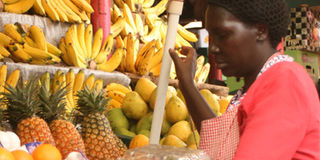Uganda’s inflation rises to 1.9 per cent

A trader sells fruits at Nakasero Market, Kampala, recently. According to UBOS, Annual inflation was driven by high prices of food. PHOTO BY FAISWAL KASIRYE
What you need to know:
The Uganda Bureau of Statistics said the rise in inflation is due to increased public expenditure on non-food items amid high prices of goods and services due to a weak shilling
Kampala.
Uganda’s annual headline inflation in the consumer price index has risen to 1.9 per cent up from 1.6 per cent in February 2014.
This means that the cost of living has gone up and the public have to adjust their expenditure on specific goods and services.
Uganda Bureau of Statistics (UBOS) attributed the rise to increase of prices of nonfood crop items such as clothes, rent, education, charges, furniture and cement, an indication that the general public’s expenditure on these items is higher than they were 12 months ago.
Releasing the consumer price index at Statistics House in Kampala yesterday, UBOS principal statistician Samuel Echoko said: “Arua centre registered the highest annual inflation of 4.8 per cent in February 2015 compared to 2.9 per cent in February, 2014. This was driven by high price levels for food, clothing, foot wear and rent.”
Mr Echoko said Kampala registered the second highest annual inflation of 2.5 per cent compared to 1.6 per cent that was recorded in February last year. The main drivers of inflation for Kampala were mainly clothing, rent, education charges.
Mr Echoko said Mbale centre registered inflation of 2.2 per cent compared to 2.4 per cent recorded in February last year.
Justification
The Uganda Bureau of Statistics said the rise in inflation is due to increased public expenditure on non-food items amid high prices of goods and services due to a weak shilling.
In the services sector, UBOS said the annual inflation for services registered 4.8 per cent in March 2015, the same rate recorded as at February 2015.
“The annual electricity, fuel and utility inflation declined by 0.8 per cent compared to a rise of 1.8 in February. On the other hand, the annual food crops registered a deflation of 6.0 per cent, compared to 7.0 per cent registered in February,” Mr Echoko said.


